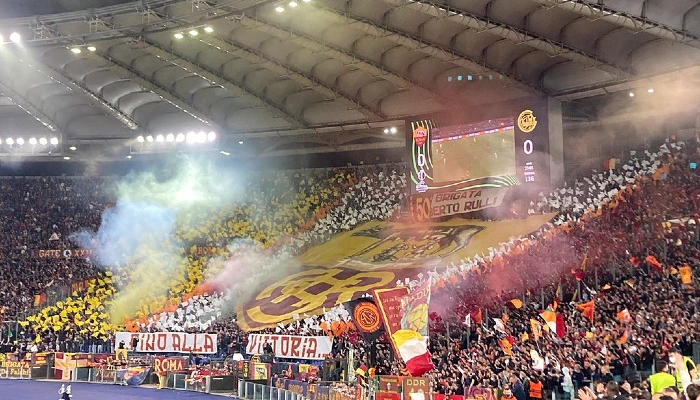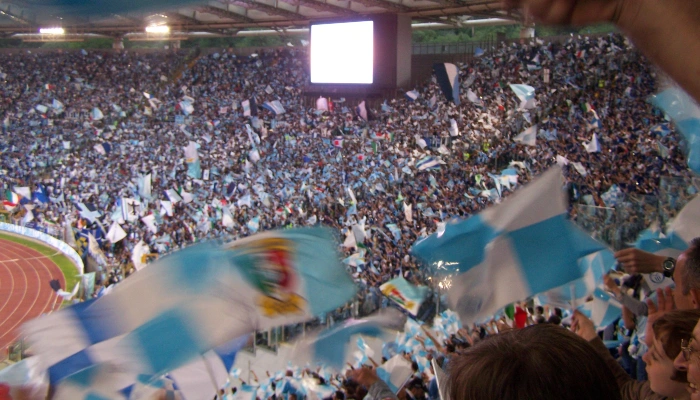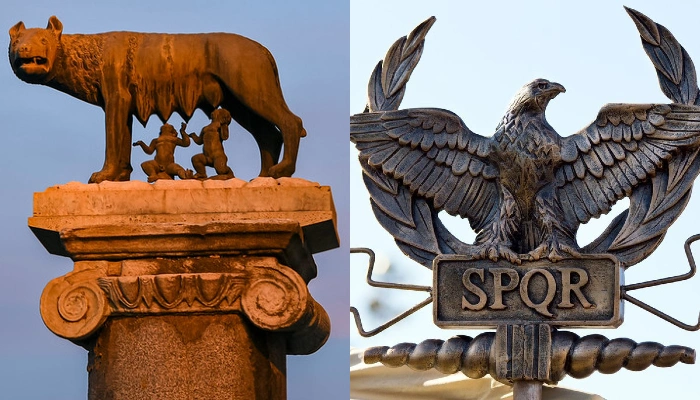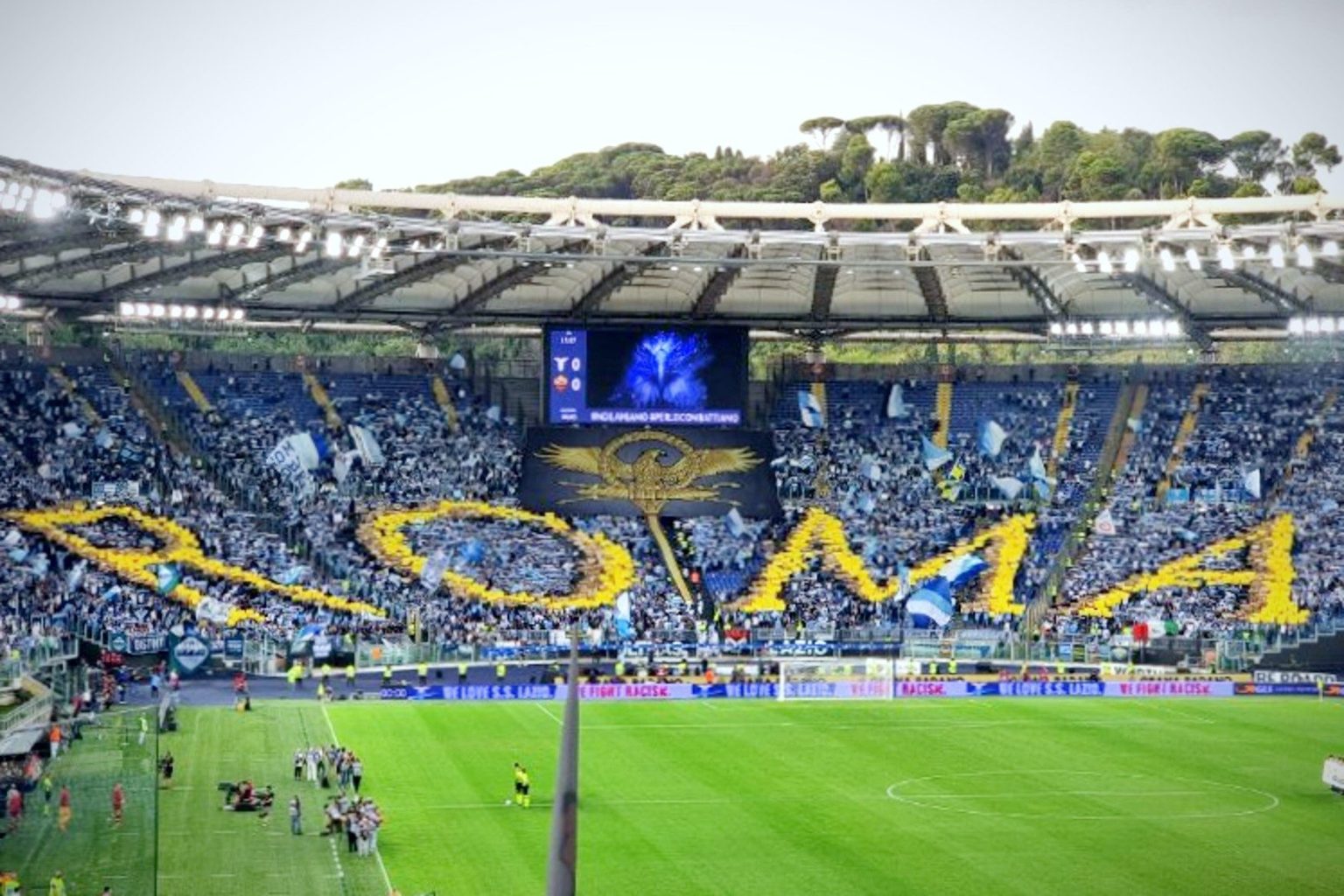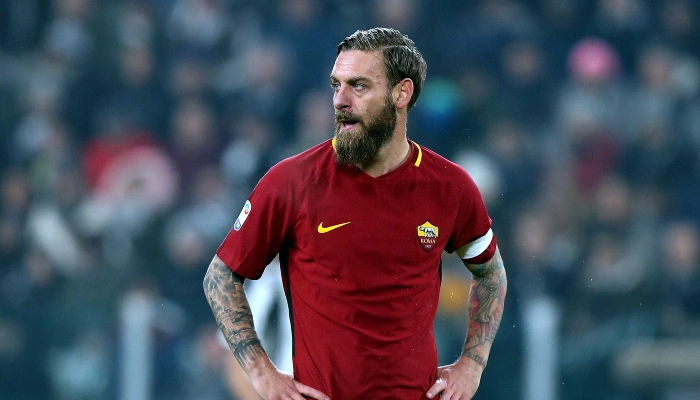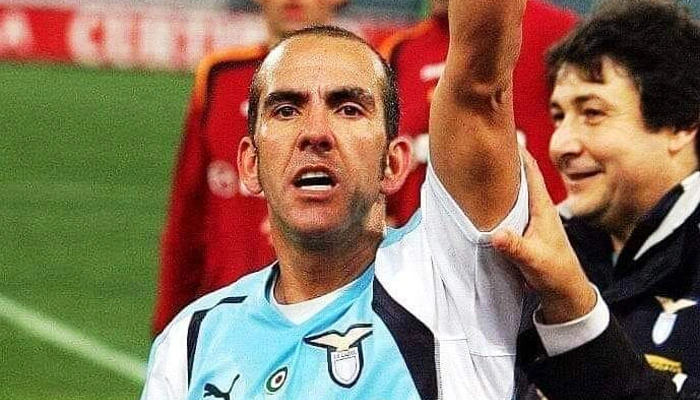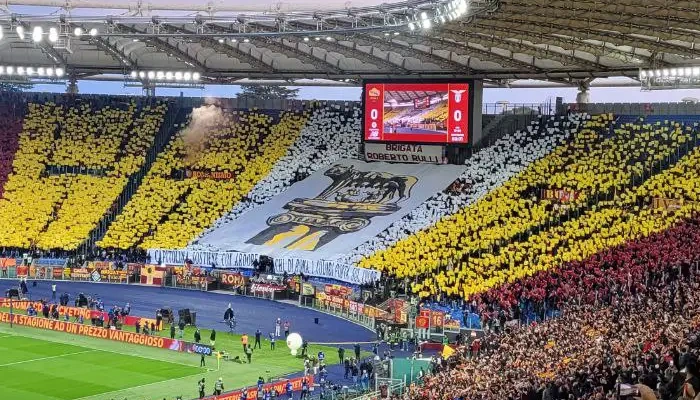Derby della Capitale
The Rome Derby: AS Roma vs SS Lazio
AS Roma and SS Lazio Tours
4 May 2025
AS Roma – Fiorentina
From 673€
11 May 2025
SS Lazio – Juventus
From 680€
18 May 2025
AS Roma – AC Milan
From 727€
What is included?
Official Premium Ticket
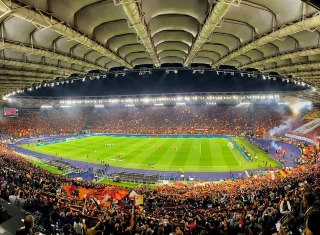
Official AS Roma or SS Lazio Ticket
We only include official tickets and we always guarantee that your ticket is valid and with a great view. We deliver your ticket as an E-ticket (PDF) that you scan in the entrance (you can scan it from your mobile phone, printing the ticket is not needed).
Our tickets are always for one of the side stands, either Tribuna Monte Mario or Tribuna Tevere. This guarantees that you have the best view of the pitch and will be able to enjoy the full experience of watching matches at the Olympic Stadium.
First Class Hotel
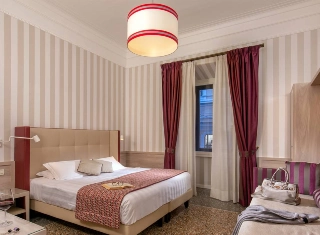
Hotel in Rome City Center
You will stay in our hand-picked hotels when you travel to Rome with us. We have personally visited and stayed in all the hotels we use, in order to present you with the best possible accommodation experience.
Furthermore, our hotels are always located next to a metro station (usually Termini - Rome's central station). This makes your visit to Rome much easier. You will be able to move hassle-free around the city and have easy access to train connections, busses and taxis to both airports in Rome.
Exclusive Travel Guide
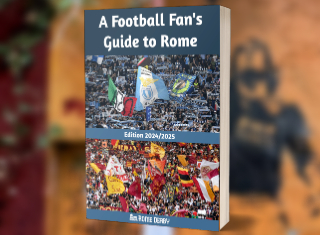
A Football Fan's Guide to Rome
Our local tour guide (and fanatical football fan) in Rome is the author of this travel guide to experiencing football in Rome.
Everything you need to know about exploring the Italian capital as a football fan. The travel guide includes match-day tips, where to go before the games, football sights in Rome, restaurants and bars for football fans, history of the Derby della Capitale and the two football clubs, and much more.
The travel guide is delivered to you by e-mail as PDF.
Our Reviews
Read more reviews on trustpilot.com.
"The next football trip will also be with Groundhopping Tours"
"The Netherlands, Scotland and Germany are so far the countries I have visited with Groundhopping Tours.
All trips have been absolutely fantastic, and there have been both top matches on the program and matches right down in the lower ranks.
I can only recommend Groundhopping Tours - so they will also plan my next football trip."
Review by Kenneth Sejer
Date of experience: December 3rd 2023
"A very good experience"
"A very good experience with Groundhopping Tours, from pre-booking inquiry over booking and info before departure to arrival at the hotel and the entire setup in Dortmund (where we saw Dortmund vs Gladbach) with stadium tour on Friday, match on Saturday and generally just good recommendations for the trip.
Groundhopping Tours gets my absolute warmest recommendation."
Review by Kasper J
Date of experience: November 24th 2023
"Good experience for Boca Juniors match"
"We were in Buenos Aires on holiday and bought tickets through Groundhopping Tours for Boca Juniors' home game.
Everything about the match worked perfectly with the local guide, so there was no reason for insecurity or confusion about the slightly complicated access procedure.
Things are under control when you buy tickets here - even if it's on the other side of the globe."
Review by Nikolaj Marker
Date of experience: October 20th 2023
Welcome to Rome
The Derby della Capitale is perhaps one of the world’s most famous local derbies. It is a match that transforms the entire city of Rome for several days. The two major Roman clubs, AS Roma and SS Lazio, share both the Italian capital and the Olympic Stadium.
SS Lazio is the older of the two clubs, but today AS Roma is the “big brother” with the most fans. The distribution of fans in Rome is approximately 70% Roma fans and 30% Lazio fans. The center and the south of Rome are typical Roma areas, especially the old neighborhoods such as Monti, Trastevere and Testaccio (where AS Roma was founded). Lazio’s fans come primarily from the northern (and more prosperous) parts of Rome, as well as from the suburbs and the Roman hinterland. The first Derby della Capitale was played on the 4th of May 1930. It ended with a 3-1 victory to Roma.AS Roma
The story of AS Roma starts with the merger of three Roman football clubs (Alba Roma, Roman and Fortitudo Pro Roma) in the summer of 1927. Behind the merger was the fascist dictator Benito Mussolini, who wanted one strong Roman club that could compete with the more successful northern Italian clubs. Lazio managed to avoid the merger and remained an independent club, although it was actually the initial plan that they were to be part of the new club as well.
AS Roma was founded in the southern part of Rome, in the Testaccio neighbourhood, which is a well-known working-class quarter. Every year on the 22nd of July, AS Roma fans celebrate the club’s birthday in this neighbourhood. The club’s first stadium, Campo Testaccio, was also located in this part of the city. You can still see the remains of this stadium today.
SS Lazio
Lazio is the oldest of the two Roman clubs. It was founded on the 9th of January 1900 in Piazza della Libertà, in the Prati district of Rome, not far from the city center. A commemorative plaque for the club can be seen on the square today and every year on the 9th of January, Lazio fans meet up here to celebrate the club’s birthday.
For many years, Lazio was the least successful of the two Roman clubs but from the 1990’s Lazio started to win titles in both Italy and Europe. Today, both Lazio and Roma are usually among the Italian teams that qualify for the European Cups, such as for example Champions League or Europa League.
The battle to be the most Roman club
A fascinating aspect of the Rome derby is that the entire atmosphere surrounding the match bears the stamp of the city’s history and grandeur. A city that was once the center of human civilization and had conquered more than half of the known world. Fans of both clubs have certainly not forgotten this. They both take pride in claiming this as part of their heritage and history.
Romanism runs deep in the two clubs and their fans. Among other places, this can be seen in the clubs logos. The logo of AS Roma includes “la lupa” (the she-wolf). This is the wolf that Rome’s founders, brothers Romolo and Remo, according to legend grew up with. Romolo kills his brother and founds Rome in 753 BC. The wolf is today the symbol of Rome and you will see this symbol present everywhere in the city. So to is the eagle, which is Lazio’s logo. The eagle is an ancient Roman symbol. A symbol of the Roman Empire that was used to lead the Roman legions into war.
The wolf and the eagle are thus two Roman symbols that the clubs have adopted several thousand years later, as part of the self-understanding of both the clubs and their supporters. Outside of Rome, in the rest of Italy, Romans are seen as arrogant and are not well liked. The Latin slogan for the city reads “Caput Mundi” (capital of the world).
This is how the Romans perceive their city, as the most beautiful and important city in the world. And they take that with them to the stadium and especially to the Rome derby, where it is important to claim Romanness and the many thousands of years of heritage.
The fan scene in Rome
The Rome derby has become an institution in not only Italian but European football. To a great extent, this can be attributed to the two clubs’ fans and the atmosphere during the derby. Unlike many other famous European football derbies, Romans have understood that a large presence of away fans contributes to the overall experience for everyone.
Roma’s ultras are always located in the south stand “Curva Sud” and Lazio’s ultras always in the north stand “Curva Nord”. For the Rome derbies, the away team is always assigned their entire “curva”, which means they can bring approximately 19,000 fans to the stadium. This contributes to a very intense atmosphere. Compare that to “El Clásico” between Barcelona and Real Madrid for example. Here, the away team is usually only represented by a few hundred fans.
Both Roma and Lazio are likewise clubs with few titles and championships compared to the big northern Italian clubs. Perhaps this is also why the Rome derby has developed into the most important match of the season for the two clubs and their fans. They know very well they are not going to win the championship, which means that the success of an entire season can be decided on whether they win the derby or not.
Last but not least, what attracts attention and interest to the Rome derbies can often be summed up in one word, drama. These derbies always provide drama both on and off the football pitch.
The political aspect of the Rome derby
The most hardcore Italian fans are called ultras. Both Roma and Lazio have ultras groups that were formed in the 1970’s when the Italian fan scene started to grow and become organized.
The 1970’s was a very turbulent time in general in Italy. The country experienced a lot of political terror and battles between far-right fascists and far-left communists. In the midst of these battles, many of the Italian ultras groups were born and founded and they brought the political battles into the stadium. The legacy of this was felt through the 1980’s, 1990’s and 2000’s, where political messages (both from the extreme right and left) were strongly present in Italian stadiums and the two Roman clubs were especially known for demonstrating these messages. Today, these political battles have largely been eradicated and political messages are banned in stadiums.
Lazio’s fan are often associated with fascism, particularly the ultras group Irriducibili. Irriducibili was founded in 1987 but it has now been disbanded. The group was world-famous for their extreme right-wing views, which they displayed in the stadium in the form of banners, flags, songs and tifos.
Today, flags with swastikas and Celtic crosses are prohibited in the stadium but in the 00’s these type of flags and banners where commonplace on Curva Nord. However, one should not be mistaken and think that Lazio no longer has fascist fans. It is not unusual to see Lazio fans doing the “saluto romano” (the Roman salute – which is the Italian version of greeting with an outstretched right arm), as well as hearing the anti-communist song; “Avanti ragazzi du Buda” (an Italian support song for the Hungarian uprising against the Soviet occupying forces in 1956). A song which today is strongly associated with fascism and which has absolutely nothing to do with football.
The point is that Italy has never seriously distanced itself from its far-right history and thus it has remained socially acceptable in many circles to sympathize with fascism. Especially in Rome, where in certain groups these types of political views blends well with the history of the Roman Empire and the eternal city’s heyday. And Lazio’s fans in particular are known for bringing these types of views into the stadium.
Three Roman Legends
Francesco Totti
It is impossible to talk about AS Roma without mentioning Francesco Totti. Perhaps the greatest of all Roman football legends. He is known for being one of very few elite players in the world who has only played for one club. From 1992 to 2017, Totti played for AS Roma’s first team, in addition to a few years as a youth player at the club. A record of 25 seasons, which will probably never be broken again at the European top level.
During his career, Francesco Totti was presented with the chance to play for the Spanish superstar team Real Madrid, but he chose in favor of his beloved city and club. Something that will never be forgotten in Rome. At the end of his last season in 2017, even the Lazio fans showed their respect to Totti. In Curva Nord they showed a banner saying “I nemici di una vita salutano Francesco Totti”, which translates to “Lifetime enemies salutes you, Francesco Totti”.
Daniele De Rossi
Daniele De Rossi is another former AS Roma player. He played 18 seasons for the club from 2001 to 2019. De Rossi ended his career at Boca Juniors in Argentina after being sacked by the club. A move which did not please Roma’s fans at all. It resulted in several days of protests in front of the club’s headquarters by many angry fans.
Had De Rossi not played at the same time as Totti, he might have been even more famous for his loyalty to the club but in the end Totti overshadowed his fame. Both Totti and De Rossi are real Romans, born in Rome. A point that is extremely important for the club’s fans. Totti was born and raised in the San Giovanni quarter, where today there are several murals of him, and De Rossi in the port city of Ostia in Rome. There are many places in Rome where you will be able to see the graffiti “DDR vanto di Roma” – which translates to “Daniele De Rossi, the pride of Rome”.
Paolo di Canio
Paolo di Canio was also born in Rome and grew up in the neighborhood of Quarticciolo in eastern Rome, an area that certainly does not have the best reputation. Di Canio played for Lazio over two spells, the first time from 1987 to 1990 and again from 2004 to 2006. He became particularly well known for publicly declaring himself a member of the famous Lazio ultras group Irriducibili. He proudly told in TV interviews how he traveled with them on away trips and was part of the group before he became a professional football player. Naturally, Lazio’s fans loved him for this.
During his time abroad, he spent most of his career playing for West Ham in England, which led to a strong fan friendship between Lazio’s and West Ham’s fans. Still to this day, you will see Lazio fans in and around stadium on match days wearing West Ham shirts and merchandise. And in the northern parts of Rome, young people are often seen wearing West Ham shirts on regular week days as well. You can be guaranteed that they are Lazio fans.
Famous Derbies
2004: The “dead” boy’s derby / the aborted derby
On March 21, 2004, one of the most famous Rome derbies was played. The derby became famous because it was never finished. In the beginning of the 00’s, Rome derbies – and matches in general in Italy – were often marked by spectator unrest. As was the case with this particular Rome derby. There had been small disturbances before the match. During the first half of the game, rumors began to circulate – at Roma’s Curva Sud – that a boy had been run over and killed by the police during these disturbances. It later turned out that the boy was not dead. But the rumors sparked an unusual unrest among the fans and especially Roma’s ultras interfered in progress of the football match.
It is worth mentioning, that during this time period, both Roma’s and Lazio’s ultras groups were extremely numerous and very powerful, and tensions between fans and police were at their absolute highest. As the second half started, three representatives from Roma’s ultras groups entered the field and demanded to speak to Roma’s captain, Francesco Totti. This lead to a long discussion between the three representatives, Totti and several other Roma players, during which the match was interrupted. The representatives demanded that the match was to be cancelled entirely because of the dead boy, and they threatened with even more riots if the game was to be continued.
As all this is happening, both Lazio’s and Roma’s fans are very inflamed and they begin setting off large amounts of fireworks inside the stadium and some begin setting fire to the seats. Under normal circumstances, the two fan groups are arch-enemies, but on this particular occasion the police became their common enemy. It all ends with Totti running back towards the center of the field to talk to the referee, as well as with the security and the police who have arrived by this time. As he passes by Roma’s bench, he shouts the famous words to his coach, Fabio Capello: “If we keep playing, they will kill us”. The match was cancelled. The Roman ultras had collectively demonstrated their power.
There are clips from the interruption of the match here: youtube.com/watch?v=35kXqfiV0vE
2008: Gabriele Sandri’s derby
On March 19, 2008, Lazio beat Roma 3-2. But this derby was also to be remembered for something else than the battle on the field. It was the first derby after the 28-year-old Lazio fan, Gabriele Sandri, was shot and killed by the police in November 2007. Gabriele Sandri had been on the way to a Lazio away game together with other Lazio fans. At a rest stop in Tuscany, they accidentally encountered some Juventus fans and the two fan groups began fighting each other. The police arrived and shot Gabriele Sandri, who died. The policeman who fired the shot was later convicted and imprisoned for murder.
The Rome derby in March 2008 was therefore the first time the two clubs played each other after the death of Gabriele Sandri. What happened this day brings another layer to the understanding of the Rome derby and football in Italy in general. Football fans are well known for their animosity towards other fans, especially their rivals. But on this particular day, the hatchet was buried between the two fan groups and the Roma fans showed a remarkable solidarity with their usual enemies.
Before the match, Roma’s fans and the club – represented by Totti – chose to show respect for the late Lazio fan. A group consisting of Totti, Gabriele Sandri’s brother and representatives from the Roma ultras, walked along the running track from the Curva Sud to the front of Lazio’s Curva Nord with flowers and a banner in honor of Gabriele Sandri. They layed out the flowers in front of a large picture of Gabriele Sandri and then spread out a banner with the inscription (translated): “Tears know no colors. Gabriele is one of us. Curva Sud”. This was followed by a big applause from all Lazio fans.
The entire stage can be seen here: youtube.com/watch?v=XARWVjnBfcI
Today, there is a memorial for Gabriele Sandri at the rest stop in Tuscany (near the city of Arezzo) and at Lazio matches flags with his image can still be seen.
A derby you have to experience
Derby della Capitale – the Rome derby – is always an exciting experience with many more elements than just the 90 minutes on the field. Rome has approximately 4 million inhabitants and the peoples interest in these two football teams is enormous. In the days leading up to any Rome derby, the atmosphere around the city is absolutely buzzing and the local newspapers are making long specials about why this particular derby is something special.
To put into perspective how important these two clubs are for the inhabitants of Rome, just ponder this fact. There are several radio stations dedicated solely to broadcasting content about the two clubs. Roma Radio, Retesport and Radio Romanista are purely AS Roma radio stations while Radiosei and Lazio Style Radio are exclusively SS Lazio. These five radio stations broadcast content about the two clubs every day. In addition, there are countless social media pages and communities that only write content about one of the two clubs.
All these aspects are something you will never get to experience when you watch a Rome derby on your television. You have to go to Rome to experience a Rome derby for real. And there is no better place to buy your Rome derby football trip than here. So round up your football friends and make the next Rome derby an unforgettable experience for everyone.

